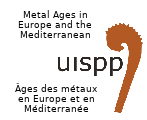In 2019, in the locality of S. Vito in Cremia, the Soprintendenza ABAP for the provinces of Como, Lecco, Sondrio, and Varese investigated a multi-layered site, with stratigraphy from the Neolithic to the Middle Ages. The levels ascribed to the Copper Age have shown the presence of a place of cultic and cerimonial activity. It is a large, monumental area with circles of boulders and stones, pits and lithic cysts containing "grave goods" and/or "offerings", associated with rare and ambiguous bone remains.
From Structure 29, dated to 3354-3009 B.C., comes a small metal axe (length c. 7.4 cm; max. width 3.3 cm). A greenish patina covers the object, uneven, rough, and sometimes vacuolar. On a macroscopic level, the axe shows no signs of use. We proceeded to conduct non-destructive measurements of the axe using an SEM-EDS microprobe in the laboratories of the University of Milan - Bicocca. In particular, the axe was analysed using a Tescan Vega xm SEM (Scanning Electron Microscope) coupled to an Edax Genesis 4000 xm EDS microprobe.
These first analyses showed that newly formed minerals due to the alteration of copper constituted the patina, in which elements from the soil participated, as shown by the peaks of silicon, aluminum, magnesium, and phosphorus. Further measurements made in a small spot on the axe – without patina - showed that this object, or at least its surface at this point, has a composition of a silver alloy with a small percentage of copper.
This paper presents the site context and associations of the discovery and the subsequent investigations, in progress, to determine the composition and characteristics of the artefact.

 PDF version
PDF version
